How to make a mini wildlife pond
A mini wildlife pond will help wildlife in your garden. Water is essential for all creatures.
And helping wildlife is part of being an environmentally responsible gardener. As Joel Ashton told me in 5 Easy Wildlife Garden Tips, all life depends on water. Creating a pond of any size is the most wildlife friendly thing you can do in your garden.
But how big does a pond have to be?
The Wildlife Trust says that you should have a minimum of 4-5 square metres of water, which would be a pond about 6ft across.
But the RSPB says that any water is helpful. Even a washing-up bowl is big enough to be a wildlife pond.
And the wildlife themselves seem to agree. In wildlife supporters Ian and Mo Parker’s garden, I saw a plastic bucket that had filled with rainwater. A frog has adopted it. Ian popped a couple of rocks in there, to help Froggy and his friends get in and out. He says it has been Froggy’s little mansion ever since.
No time to read now? Pin this for later…
And if you’d rather watch a video than read a post, the make a mini wildlife pond video is here.
I made this mini wildlife pond seven years ago. Here is a photo of it in 2022 and it looks just as good now in 2024. It has been no trouble to look after. If you create your pond properly, it will almost look after itself.
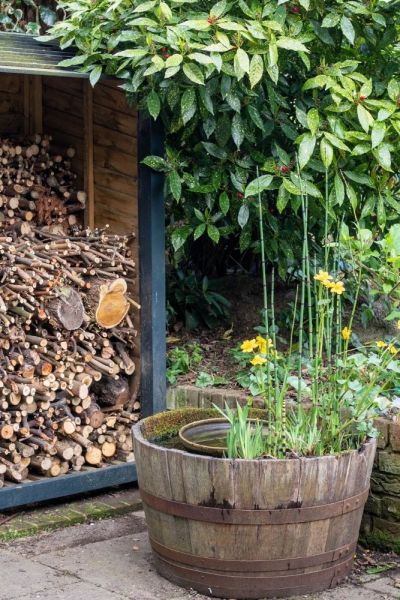
This mini wildlife pond on my terrace is now 8 years old. I occasionally rinse out the top saucer but otherwise it is very low maintenance. It doesn’t smell or get stagnant because the eco-system has been balanced with the right plants.
How to make the perfect mini-pond
I bought a half oak barrel to use as a mini wildlife pond. You can buy them on Amazon here. I’m an Amazon affiliate, see disclosure.
But it took me six months to find out how to make a mini wildlife pond properly.
The first thing I discovered is that oak barrels are not ideal for this purpose. Their high sides mean that wee beasties have trouble getting in and out of it.
Luckily, however, our terrace is stepped down from the garden, so the top of the oak barrel is accessible from one of the beds. You can also build access up around a high sided mini pond with pots of plants or even bricks.
Nothing else seemed simple, however. I initially felt overwhelmed by the amount of contradictory information out there. I have, I hope, simplified it for you.
Where to place your mini wildlife pond
Ponds must be in sunlight… but not such bright sunlight that the water will get too hot in a very small area.
Some people advise making sure that there is plenty of over-hanging vegetation for wee beasties to shelter in. Others say not to put ponds under trees or plants that shed their leaves.
I have been told that I need pond liners with different levels because aquatic plants need to be planted at different depths. Some people also advise adding a fountain or pond pump to keep the water moving.
Remember that once your mini pond is full of water, it will be very difficult to move. So decide where it will go early on – and even before buying it. Where it goes may affect the shape you buy. Jane Beedle only had a long, thin space for a pond so she made a container pond out of an old agricultural feed trough.
I think that if I’d thought this through a rectangular mini pond would have been for my terrace, too. But I’d already bought the oak barrel.
You need certain plants in your mini-pond.
Firstly, you need oxygenating plants. You also need plants that stick up, such as irises or equisetum, so that young dragonflies can crawl up them.
Remember access to a mini wildlife pond
If you have a high sided mini pond, place stones or bricks inside, so that creatures can climb out. And to help them get in, arrange different levels of pots around the mini-pond container.
It’s also important to choose a container that is ‘water-tight, frost-proof and clean.’
Oh dear, that reminds me that I was told that oak barrels once used for whisky might still have chemicals that might leach into the water….I am beginning to think I should call this post ‘How Not To Make a Mini Wildlife Pond.’
The basic points are:
Eventually I decided that it was time to stop agonising over the best way to create a mini pond and Just Do It. The local garden centre stocked a trio of wildlife pond plants in a handy kidney-shaped tub.
I also bought oxygenating plants. These are small plants that look like freshwater seaweed and have little weights attached. You just throw the oxygenating plant in the barrel.
The three wildlife plants came in their own basket and didn’t need more soil or compost. I balanced them on bricks to bring their height up. If you do need more soil or compost, you must use aquatic compost, not ordinary soil or compost.
In seven years, I have never fertilised them or changed their compost. As you can see from the third image down in this post, they are still flowering in 2022.
The gravel you use should also be labelled as suitable for ponds.
I was concerned that the pond is in too shady an area, but it has nothing directly hanging over it. And I’ve found a piece of flagstone to balance on more bricks to create a platform for birds to stand on. Seven years later, the water still seems clear, although some leaves do drop into it.
But don’t try to stock your pond…
Next – you need to get the wildlife into the pond. Asking other people for frogspawn, apparently, could transfer disease from one area to another.
Don’t have fish as they will eat the eggs and larvae…I’d no idea that creating a mini wildlife pond could be such an anxiety-inducing activity.
However, most people report that once you’ve built a wildlife pond, the wildlife find it quickly.
One important mini wildlife pond warning…
Don’t forget that babies or toddlers can drown in a few inches of water. Protect them from the pond.
We now peer at the barrel pond on an hourly basis to see if wildlife are attracted to it. So far…I’ve seen one little insect scudding across the surface. I think it was a mosquito…. (Note: seven years later, I can report that this mini wildlife pond has not encouraged mosquitoes – but we live in South East England, which does not tend to get many anyway.)
More help for wildlife in small gardens
Even a small lawn can be turned into a mini-meadow. This looks wonderful for months at a time, and helps pollinating insects. And it’s easy – but not as simple as just letting your grass grow. See here to find out how to create a beautiful mini-meadow garden.
If you tried growing the lawn long and were disappointed by lots of green, floppy grass and no meadow flowers, see Top Meadow Lawn Mistakes and How to Avoid Them.
If you want a glorious herbaceous border and a fairly formal look to your garden, but you’d also like to be wildlife friendly, then read about how they combine a beautiful garden with sustainable gardening and wildlife friendly planting at Great Dixter.
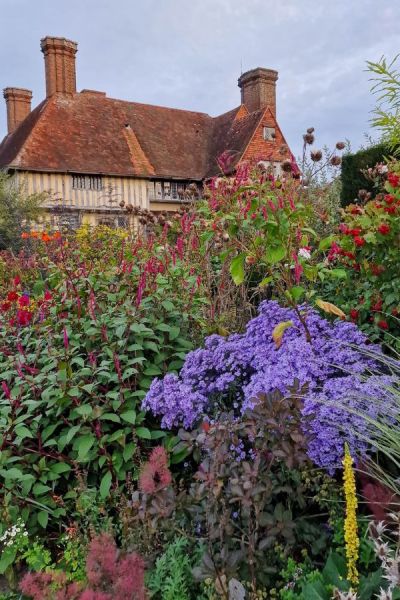
Great Dixter is one of the most famous gardens in the world. It combines sustainable, wildlife-friendly planting with beautiful borders.
For more self-seeded plants or wildflowers in your garden, read this post listing 25 brilliant self-seeded plants to save you time and money.
Give your garden a wildlife-friendly audit by checking What Makes a Good Wildlife Garden. You need to provide food, access, shelter and water.
But it is really easy, provided you know what the wildlife needs. There’s more advice in 12 easy ways to help wildlife in your garden.
And did you know that butterflies are a good indicator of how healthy your garden environment is? Create a garden for butterflies, and you’ll help other wildlife. See Why You Need a Butterfly Garden – and How to Plant It.
And don’t worry about where the wildlife will come from
They will find you if you have what they need!
Finally, do you worry about light pollution? If you’re concerned that having Christmas lights in your garden in winter will disturb or disorientate wildlife, here are some wildlife-friendly tips for decorating your Christmas garden!
And if you provide water in your garden, you’ll make a big difference to birds, frogs and all other wildlife. If you’ve got room for a bigger pond, then there are some lovely ideas for garden ponds here.
If you’d like to think big and have a large wildlife pond in your garden, it’s definitely worth reading how Anne Vincent re-routed the rainwater from her guttering to create a wonderful wildlife haven in a small town garden.
Shop my favourite sustainable gardening products
I’m often asked for recommendations (garden tools, books etc). So I’ve put together some lists of the gardening products I use on The Middlesized Garden Amazon store.
And I’ve included some of the products I use for more sustainable gardening. I’d always recommend, for example, using the largest water butt you can fit in or afford. Smaller water butts run out more quickly and there are some good slimline water butts now. There are also recyclable pots for seedlings, biodegradable twine, wooden plant labels, bug hotels and more. See My Fave Sustainable Gardening Products.
I also have a range of t-shirts, hoodies and tote bags on the Middlesized Garden Teemill store. They are made from natural materials, manufactured with renewable energy and delivered in plastic free packaging. So if you’re looking for sustainable fashion or for a present for someone who cares about gardening and sustainability, check them out.
And read award-winning journalist and author Kate Bradbury’s book for the Wildlife Trusts called Wildlife Gardening for Everyone and Everything.
Pin to remember how to make a mini wildlife pond
We often cover wildlife-friendly and sustainable gardening on the Middlesized Garden. So if you’d like a free weekly email with gardening tips, ideas and inspiration, see here.

The Middlesized Garden is a participant in the Amazon Associates LLC, an affiliate advertising programme designed to provide a means for sites to earn advertising fees by advertising and linking to Amazon.co.uk

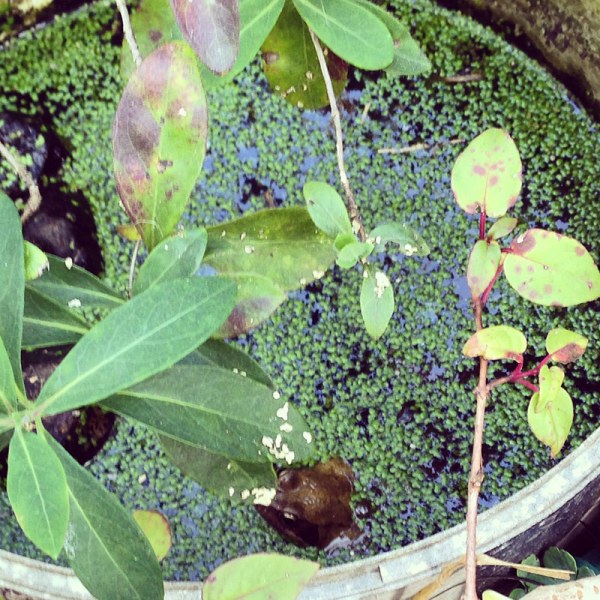
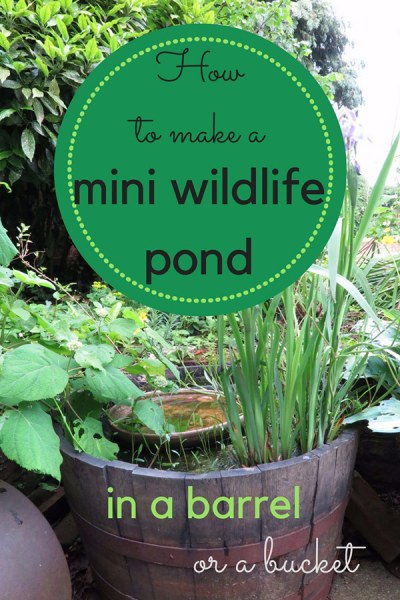
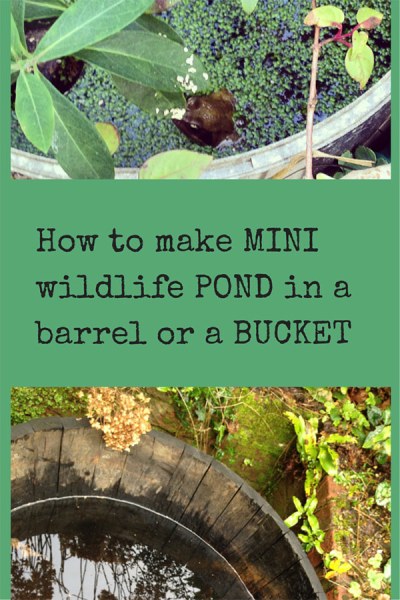
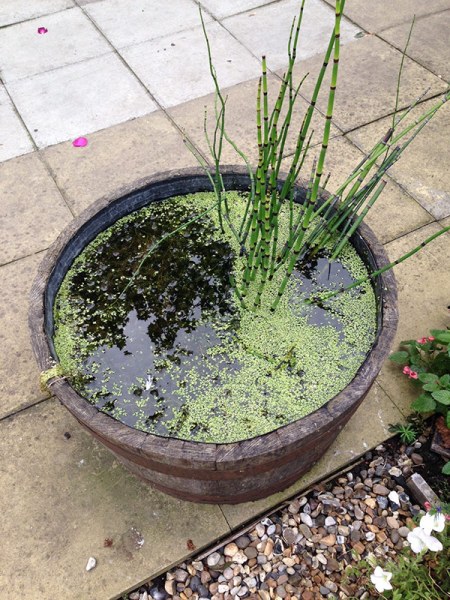
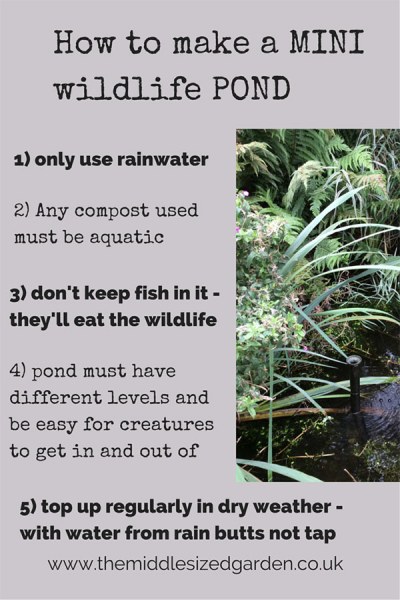
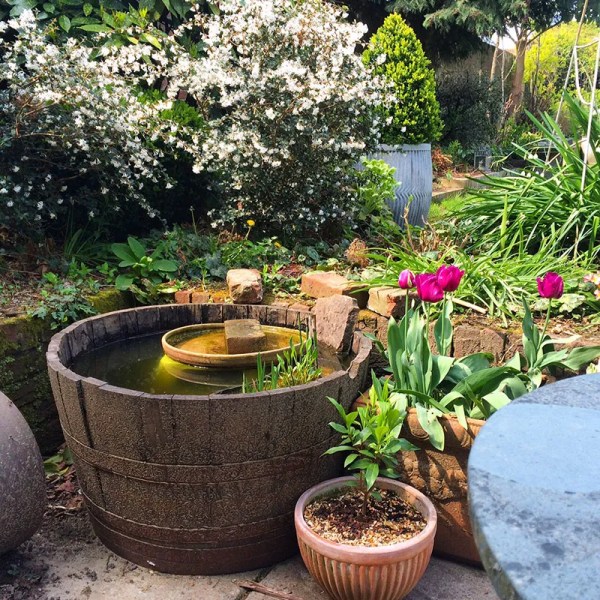
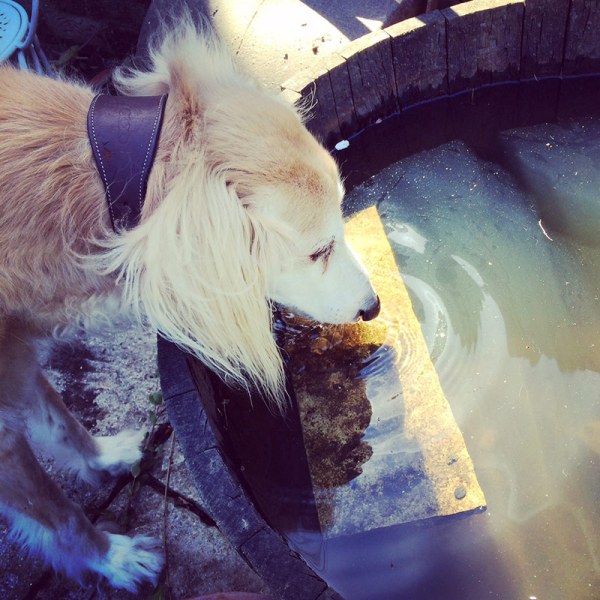
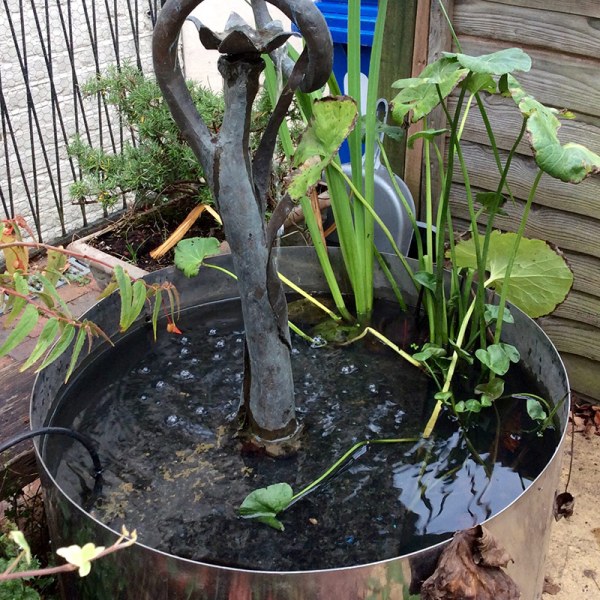
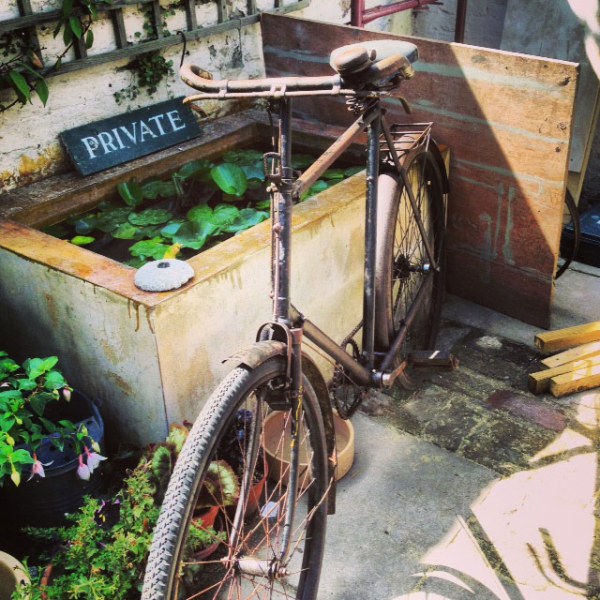
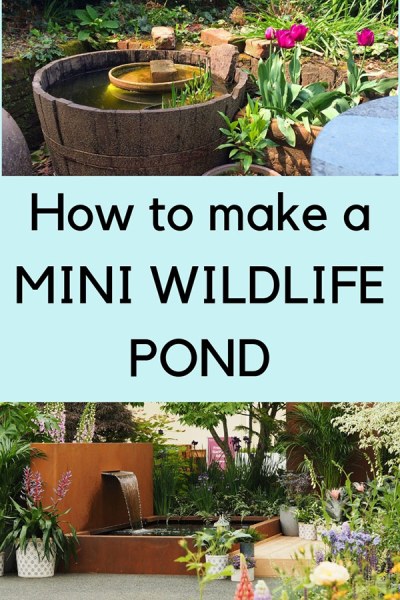






















Any suggestions on how to fill a mini pond without using tap water when we don’t have a water butt? It’s main purpose will be for birds and insects, possibly small mammals..
You can use tap water if you let it stand for a few days, advises the Wildlife Trust. When you first fill the pond, it won’t have any wildlife in it anyway, so don’t add anything (such as water snails) until it’s been standing for about a week to let chemicals evaporate. Then keep a watering can filled and standing by, so you can top up without taking water straight from the tap. If the weather is quite rainy, it will fill naturally but in dry spells, you will need to keep it topped up.
Move up here to Scotland! Mine was full within a few months!
You can make small lily ponds as well.
Some municipalities require fish that will eat mosquitoes or mosquito killing tablets in any standing water (including ponds).
Fish and lily ponds go great together, and you can use tap water on them, although you should consult about what to do to treat your pond before putting any fish in.
The dechlorinating tablets or drops which work for aquariums and fish bowls also work for ponds.
Yes, you’re right, although you need to decide if you are having a fish pond or a wildlife pond, as the fish eat the other insect wildlife, such as dragonflies, as well as the mosquitos.
water boatmen will find new water within days. they eat mosquito larvae. no need to worry
Good point!
Hi there,
I ‘m looking to put in a tiny pond 3’x2’ next to a wall in my back garden. Unfortunately it is the hottest part of the garden but I simply cannot site it anywhere else. Do you have any tips to counter the heat of Summer. Many thanks
Can you put any shade over it? Such as a parasol or canopy? Small ponds do overheat if they’re sited in sunny positions. It may also help if you surround it with pots so that the sides of the pond aren’t directly being heated by the sun if it’s a raised pond. And if it’s not raised,the pots and plants in the pots should help provide some shade. Hope that helps
Hiya,
I’ve bought a teeny pot, 36cm diameter and about 20 cm deep plus 2 pond plants and filled it with rain water. I’m really worried that it’s too small after reading other comments and scouring the internet. I’ve also put in some tadpoles as I desperately need frogs to gobble up my slug problem and also now worried that the container is too small. It’s only day 1 but I’m a worry wart and would hate for any living creature to die coz i got it wrong! Do I need oxygenating plants for such a small pot? I don’t think I can have a pump also as it’s too small so is that also going to be a problem??? Any advice would be great.
Thanks
Heidi
It sounds as if it may be a little small, but I have known frogs be quite happy in buckets. If you can find a larger container, that would probably be better, but if not make sure it’s not standing in direct sunlight, as the water may heat up. It’s also important to make sure that smaller containers don’t dry out. And also make sure that wee beasties can get in and out. Even if frogs don’t enjoy it, birds and insects will appreciate the water source.
Thank you for such a helpful post. Im planning on setting up a mini pond to encourage more toads into the veg plot since the family of hedgehogs seems to have deserted us. And the slugs think its party time (providing them with beer traps hasn’t helped!)
Interesting that people disagree that ponds can be small. When I was much younger I made a tiny pond in my parents garden with the idea of getting fish. Before I had a chance to convince my parents that our 4 cats wouldnt use it as a self serve sushi bar, it was filled with wild life. Stayed that way for years.
I plan to use an underbed storage box thats wide and fairly shallow. Will fill with pebbles and some larger stones, add some weed, maybe a plant and fingers crossed some passing toad will call it home…
Thanks for the inspiration! Love your blog!
Your underbed storage box idea sounds great. Hope it goes well, and thank you for commenting.
Hello,not had any luck with my little pond,it’s a large plant tub I put in the ground last year and is in a sunny spot,had plants in a rocks,my sister gave me some tadpoles.I’ve emptied it out as the only thing in there was algae,and green water,think tadpoles died,because saw 1 or 2 last month not seen any since! Dont know what to do with it,left it empty!
Did you fill it with tap water – that could be a problem…it’s difficult to say why some small mini-ponds flourish and others don’t, but it’s worth doing for the birds and pollinating insects even if you don’t get any frogs or toads. Birds and insects need a bit of shallow water so if you can wedge a plate or tray just under the water level, that might help. Or you might find that if you just leave it, it will fill with rain water and whatever wants to use it will do so.
Two years ago we made a small, shallow pond in our small garden. Just dug a hole and lined it. We saw a couple of frogs in the first week and perhaps three or four last year. This week we now have frogspawn. I worry that it’s not a tidy looking pond such as those I see on some sites. But we have dragon and damsel flies, a variety of beetles and lots of different tiny beasties. I too worried about plants, algae, water quality etc. Why worry though? The wildlife love it. Got half a barrel to sort tomorrow now.
That sounds lovely. Hope the half barrel turns out well – ours is now a year on and the sparrows jostle to bathe in the shallow area we’ve created by adding a flattish drip tray (from a large pot) just under the water.
Hi
Do you know if one can use water collected in a water butt to fill a barrel pond?
Yes, you can. We did it and it’s better than using tap water as it doesn’t have chemicals
Hi, I have a similar barrel which I would like to turn into a pond. Some of the planks on mine are a little loose and I am concerned it will not be watertight- have you lined yours and if so what did you use?
When I bought mine, I was advised to make sure it was always full of water, or the wood would shrink which would make the planks loose. They do look loose but aren’t. I think perhaps the best thing would be to fill it and see what happens as the wood may swell and make it water-tight, but if not, I think a trip to a garden centre for a liner would be a good idea. If you do get a liner you might be able to make different levels (needed for little creatures to get in and out). Good luck, hope it goes well.
Last year I emptied out 3 ft of soil from what had been a pond and then lined it with a butyl liner. I filled it with tap water and then added oxygenating weed both from a friend and from a garden centre. It attracted wildlife almost immediately and a year on we have frogs, insects, especially bees and birds using it. I do top it up with tap water when the level drops but make sure not to add more than 1/4 approx of the water volume with tap water. You can always do a little and often. The two small water lilies seem to be enjoying it.
Hi There,
My daughter brought home some frogspawn about 7 years ago and we hastily turned our hippo shaped sandpit into an impromptu pond. We have frogs and tadpoles ever since!! All we did was ensure there were rocks at the edge for froglets to climb out and a few rocks in it as well. We put no aquatic plants in it but I am researching about moving it to another container as the hippo isn’t pleasing to the eye…. my advice is just do it!!
Lovely – thank you for getting in touch.